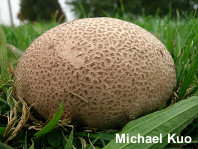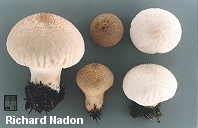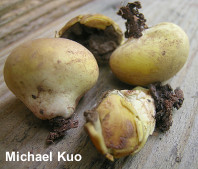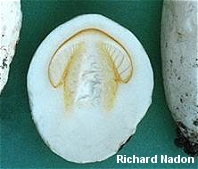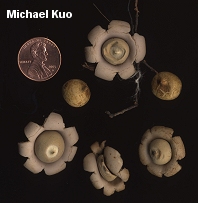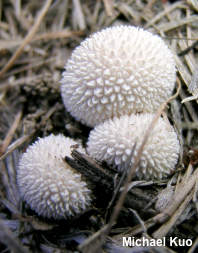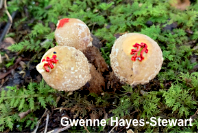| Major Groups > Puffballs |

|
Puffballs by Michael Kuo The term "puffball," as I am using it here, is not at all scientific; I mean more or less any mushroom that looks like a ball when mature. Typically the interior of a puffball is composed of spore-producing flesh that turns into spore dust as the mushroom matures. When the puffball matures it splits open, or a perforation develops on surface of the ball, through which the spores escape—when raindrops land on the puffball, via air currents, or by some other means. Puffballs range widely in size and appearance—from tiny species that grow in clusters on wood, to large, terrestrial species growing in fairy rings in meadows. A few species, like Calvatia gigantea, are enormous, reaching diameters of 50 cm! I am including the "earthstars" with the puffballs since they consist, at maturity, of a puffball sitting atop a star-shaped arrangement of fleshy arms—as well as the so-called "stalked puffballs," which consist of a ball-like spore case that sits atop a stem. When sliced open, puffballs contain only flesh—or, if they have matured, spore dust. This separates them from buttons of some gilled mushrooms that have universal veils and can appear like puffballs, since those mushrooms display the future mushroom in cross-section. Some slime molds can appear like puffballs, as well, but when sliced open they are filled with gooey, gelatinous material. Stinkhorn "eggs" are also gelatinous inside, and display the stinkhorn-to-be when sliced open. Taxonomically, the term "puffballs" is incoherent, since they are so diverse and come from many different families and genera (even different phyla!). Many belong in the gilled mushroom order (many in the Lycoperdaceae family) while others are more closely related to the boletes, a few are related to the stinkhorns. If your puffball is growing underground or partially underground, it may well be a truffle or false truffle. I have not yet treated these mushrooms at MushroomExpert.Com, beyond a few species pages (see Tuber lyonii and Zelleromyces cinnabarinus for examples). Species Pages
Arachnion album |
|
|
References Alves, C. R. & V. G. Cortez (2016). Gasteroid Phallomycetidae (Basidiomycota) from the Parque Estadual São Camilo, Paraná, Brazil. Iheringia Serie Botanica 71: 27–42. Atkinson, G. F. (1903). A new species of Calostoma. The Journal of Mycology 9: 14–17. Baseia, I. G. & A. I. Milanez (2002). Geastrum setiferum (Gasteromycetes): a new species with a setose endoperidium. Mycotaxon 84: 135–139. Baseia, I. G., M. A, Cavalcanti & A. I. Milanez (2003). Additions to our knowledge of the genus Geastrum (Phallales, Geastraceae) in Brazil. Mycotaxon 85: 409–416. Baseia, I. G. (2003). Contribution to the study of the genus Calvatia (Lycoperdaceae) in Brazil. Mycotaxon 88: 107–112. Baseia, I. G. (2005). Some notes on the genera Bovista and Lycoperdon (Lycoperdaceae) in Brazil. Mycotaxon 91: 81–86. Baseia, I. G. & Calonge, F. D. (2006). Geastrum hirsutum: a new earthstar fungus with a hairy exoperidium. Mycotaxon 95: 301–304. Baseia, I. G., B. D. B. Silva, A. G. Leite & L. C. Maia (2007). O gênero Calostoma (Boletales, Agaricomycetidae) em áreas de cerrado e semi-árido no Brasil. Acta Botanica Brasilica 21: 277–280. Bates, S. T. (2004). Arizona members of the Geastraceae and Lycoperdaceae (Basidiomycotina, Fungi). Masters thesis, Arizona State University. Bates, S. T., R. W. Robertson & D. E. Desjardin (2009). Arizona gasteroid fungi I: Lycoperdaceae (Agaricales, Basidiomycota). Fungal Diversity 37: 153–207. Binder, M. & Bresinsky, A. (2002). Derivation of a polymorphic lineage of Gasteromycetes from boletoid anscestors. Mycologia 94, 85–98. Burnap, C. E. (1897). Contributions from the cryptogamic laboratory of Harvard University. XXXVIII. Notes on the genus Calostoma. Botanical Gazette 23: 180–192. Burk, W. R. & Lupone, G. F. (1979). Pisolithus tinctorius, a pavement breaker in southern California. Mycotaxon 8: 469–470. Cabrera-Rodríguez, A., J. Pérez-Moreno, M. Torres-Aquino, G. Olmos-Oropeza, J. F. Martínez-Montoya, J. Palacio-Nuñez & J. A. Flores-Cano (2021). Ectomycorrhizal association of Astraeus aff. hygrometricus (Pers.) Morgan with an oak forest relict in the Altiplano potosino, Mexico. Revista Chapingo Serie Ciencias Forestales y del Ambiente 28: 319–329. Cairney, J. W. G. (2002). Pisolithus—death of the pan-global super fungus. New Phytologist 153: 199–211. Calonge, F. D., M. Mata & J. Carranza (2003). Calvatia sporocristata sp. nov. (Gasteromycetes) from Costa Rica. Revista de Biologica Tropical 51: 79–84. Calonge, F. D., G. Guzmán & F. Ramírez-Guillén (2004). Observaciones sobre los Gasteromycetes de México depositados en los herbarios XAL y XALU. Boletín de la Sociedad Micológica de Madrid 28: 337–372. Calonge, F. D., M. Mata & J. Carranza (2005). Contribucion al catalogo de los Gasteromycetes (Basidiomycotina, Fungi) de Costa Rica. Anales del Jardin Botanico de Madrid 62: 23–45. Carlsson, R. & C. -A. Hæggström (2005). Geastrum rufescens in the Åland Islands, SW Finland. Karstenia 45: 63–68. Castro-Mendoza, E., O. K. Miller, Jr. & D. A. Stetler (1983). Basidiospore wall ultrastructure and tissue system morphology in the genus Calostoma in North America. Mycologia 75: 36–45. Coker, W. C. & Couch, J. N. (1928). The Gasteromycetes of the eastern United States and Canada. Chapel Hill: University of North Carolina Press. Reprinted by Dover Publications, 1974. Cortez, V. G., F. D. Calonge & I. G. Baseia (2007). Rick's species revision 2: Lycoperdon benjaminii recombined in Morganella. Mycotaxon 102: 425–429. Cortez, V. G., I. G. Baseia & R. M. B. Silveira (2013). Gasteroid mycobiota of Rio Grande do Sul, Brazil: Lycoperdon and Vascellum. Mycosphere 4: 745–758. Demoulin, V. (1972). Espèces nouvelles ou méconnues du genre Lycoperdon (Gastéromycètes). Lejeunia 62: 1–30. Demoulin, V. (1973). Phytogeography of the fungal genus Lycoperdon in relation to the opening of the Atlantic. Nature 242: 123–125. Demoulin, V. (1976). Species of Lycoperdon with a setose exoperidium. Mycotaxon 3: 275–296. Demoulin, V. (1983). Clé de détermination des espèces du genre Lycoperdon présentes dans le sud de l'Europe. Revísta de Biologia 12: 65–70. Demoulin, V. & M. Lange (1990). Calvatia turneri (Ellis et Everh.) Demoulin et M. Lange, comb. nov., the correct name for C. tatrensis Hollos. Mycotaxon 38: 221–226. Demoulin, V. (1993). Calvatia pachyderma (Peck) Morg. and Gastropila fragilis (Lev.) Homrich et Wright, two possible names for the same fungus. Mycotaxon 46: 77–84. Douanla-Meli, C., E. Langer & F. D. Calonge (2005). Geastrum pleosporus sp. nov., a new species of Geastraceae identified by morphological and molecular data. Mycological Progress 4: 239–250. Esqueda, M., T. Herrera, E. Perez-Silva, A. Aparicio & G. Moreno (2002). Distribution of Battarrea phalloides in Mexico. Mycotaxon 82: 207–214. Fazolino, E. P., F. D. Calonge & I. G. Baseia (2008). Geastrum entomophilum, a new earthstar with an unusual spore dispersal strategy. Mycotaxon 104: 449–453. Garrido-Benavent, I. (2014). The Battarrea phalloides-stevenii complex: multiple sources of evidence as a strategy to unveil cryptic species within poorly characterized taxa. Butlletí Societat Micològica Valenciana 19: 17–36. Grand, L. F. (1976). Distribution, plant associates and variation in basidiocarps of Pisolithus tinctorius in the United States. Mycologia 68: 672–678. Gube, M. (2007). The gleba development of Langermannia gigantea (Batsch: Pers.) Rostk. (Basidiomycetes) compared to other Lycoperdaceae, and some systematic implications. Mycologia 99: 396–405. Hemmes, D. E. & D. E. Desjardin (2011). Earthstars (Geastrum, Myriostoma) of the Hawaiian Islands including two new species, Geastrum litchtiforme and Geastrum reticulatum. Pacific Science 65: 477–496. Hernández Caffot, M. L., G. Robledo & L. S. Domínguez (2013). Gasteroid mycobiota (Basidiomycota) from Polylepis australis woodlands of central Argentina. Mycotaxon 123: 491–492. Homrich, M. H. & J. E. Wright (1973). South American Gasteromycetes. The genera Gastropodia, Lanopila and Mycenastrum. Mycologia 65: 779–794. Hughey, B. D., G. C. Adams, T. D. Bruns & D. S. Hibbett (2000). Phylogeny of Calostoma, the gelatinous-stalked puffball, based on nuclear and mitochondrial ribosomal DNA sequences. Mycologia 92: 94–104. Jarvis, S. S. (2014). The Lycoperdaceae of California. Ph. D. thesis, San Francisco State University. 336 pp. Jeppson, M., R. H. Nilsson & E. Larsson (2013). European earthstars in Geastraceae (Geastrales, Phallomycetidae)—a systematic approach using morphology and molecular sequence data. Systematics and Biodiversity 11: 437–465. Jeppson, M. (2018). Lycoperdon Pers.: Pers. In Knudsen, H. & J. Vesterholt, eds. Funga Nordica: Agaricoid, boletoid, clavarioid, cyphelloid and gastroid genera. Copenhagen: Nordsvamp. 643–650. Jeppson, M. (2018). Puffballs of Northern and Central Europe. Göteborg: Sveriges Mykologiska Förening. 360pp. Kasuya, T., K. Hosaka, K. Uno & M. Kakishima (2012). Phylogenetic placement of Geastrum melanocephalum and polyphyly of Geastrum triplex. Mycoscience 53: 411–426. Khalil, A. M. A, H. M. Lee, G. P. Sharples, P. Sihanonth, N. Suwannasai, E. Sangvichien, M. A. Whalley & A. J. S. Whalley (2015). Daldinia: The nature of its concentric zones. Mycoscience 56: 542–548. Kim, C. S., J. W. Jo, Y. -N. Kwag, G. -H. Sung, J. -G. Han, B. Shrestha, S. -O. Oh, S. -Y. Kim, C. -H. Shin & S. -K. Han (2016). Two new Lycoperdon species collected from Korea: L. albiperidium and L. subperlatum spp. nov. Phytotaxa 260: 101–115. Kreisel, H. (1989). Studies in the Calvatia complex (Basidiomycetes). Nova Hedwigia 48: 281–296. Kreisel, H. (1992) An emendation and preliminary survey of the genus Calvatia (Gasteromycetidae). Persoonia 14: 431–439. Kreisel, H. (1993). A key to Vascellum (Gasteromycetidae) with some floristic notes. Blyttia 51: 125–129. Kreisel, H. (1994). Studies in the Calvatia complex (Basidiomycetes) 2. Feddes Repertorium 105: 369–376. Krüger, D., M. Binder, M. Fischer & H. Kreisel (2001). The Lycoperdales: A molecular approach to the systematics of some gasteroid mushrooms. Mycologia 93: 947–957. Krüger, D. & H. Kreisel (2003). Proposing Morganella subgen. Apioperdon subgen. nov. for the puffball Lycoperdon pyriforme. Mycotaxon 86: 169–177. Lander, C. A. (1934). The development of the fruiting body of Arachnion album. Journal of the Elisha Mitchell Scientific Society 50: 275–282. Lange, M. (1990). Arctic Gasteromycetes II. Calvatia in Greenland, Svalbard and Iceland. Nordic Journal of Botany 9: 525–546. Lange, M. (1993). Classifications in the Calvatia group. Blyttia 51: 141–144. Larsson, E. & M. Jeppson (2008). Phylogenetic relationships among species and genera of Lycoperdaceae based on ITS and LSU sequence data from north European taxa. Mycological Research 112: 4–22. Lebel, T., Pennycook, S. & M. Barrett (2018). Two new species of Pisolithus (Sclerodermataceae) from Australasia, and an assessment of the confused nomenclature of P. tinctorius. Phytotaxa 348: 163–186. Lloyd, C. G. (1908). Mycological Writings. Volume II. Cincinnati. Long, W. H. (1943). Studies in the Gasteromycetes: VIII. Battarrea laciniata. Mycologia 35: 546–556. Long, W. H. (1946). Studies in the Gasteromycetes: XII. Five species of Tylostoma with membranous exoperidia. Mycologia 38: 77–90. Magallon-Puebla, S. & S. R. S. Cevallos-Ferriz (1993). A fossil earthstar (Geastraceae; Gasteromycetes) from the late Cenozoic of Puebla, Mexico. American Journal of Botany 80: 1162–1167. Martin, F., J. Díez, B. Dell & C. Delaruelle (2002). Phylogeography of the ectomycorrhizal Pisolithus species as inferred from nuclear ribosomal DNA ITS sequences. New Phytologist 153: 345–357. Martín, M. P. (1997). Exoperidium and spores of Calvatia utriformis. Mycotaxon 61: 381–387. Martín, M. P. & H. Johannesson (2000). Battarrea phalloides and B. stevenii, insight into a long-standing taxonomic puzzle. Mycotaxon 76: 67–75. Miller, O. K. Jr., H. H. Burdsall, Jr., G. A. Laursen & I. B. Sachs (1980). The status of Calvatia cretacea in arctic and alpine tundra. Canadian Journal of Botany 58: 2533–2542. Miller, O. K. Jr. & W. B. Askew (1982). The genus Gastrosporium in North America. Canadian Journal of Botany 60: 364–368. Miller, O. K. & Miller, H. H. (1988). Gasteromycetes: Morphological and developmental features with keys to the orders, families, and genera. Eureka, CA: Mad River Press. 157 pp. Miller, O. K. Jr., R-L. Brace & V. Evenson (2005). A new subspecies of Mycenastrum corium from Colorado. Mycologia 97: 530–533. Morales, M. I. & J. W. Kimbrough (1978). The Lycoperdaceae of North Central Florida. I. The genera Calvatia and Disciseda. Revista de Biologia Tropical 26: 227–236. Ochoa, C., N. Ayala, G. Guzman & L. Montoya (1990). Contribucion al conocimiento de los Gasteromycetes de la peninsula de Baja California, Mexico. Brenesia 33: 51–60. Ochoa, C., G. Moreno, A. Altes & H. Kreisel (1998). Calvatia pygmaea (Gasteromycetes) in the deserts of Baja California Sur (Mexico). Cryptogamie, Mycologie 19: 131–137. Oliveira Sousa, J. de, B. D. B. da Silva & I. G. Baseia (2014). Geastrum from the Atlantic forest in northeast Brazill—new records for Brazil. Mycotaxon 129: 169–179. Pérez-Silva, E., T. Herrera & M. Esqueda-Valle (1999). Species of Geastrum (Basidiomycotina: Geastraceae) from Mexico. Revista Mexicana de Micología 15: 89–104. Phosri, C., R. Watling, M. P. Martín & A. J. S. Whalley (2004). The genus Astraeus in Thailand. Mycotaxon 89: 453–463. Phosri, C., M. P. Martín, N. Suwannasai, P. Sihanonth & R. Watling (2012). Pisolithus: a new species from southeast Asia and a new combination. Mycotaxon 120: 195–208. Phosri, C., M. P. Martín & R. Watling (2013). Astraeus: hidden dimensions. IMA Fungus 4: 347–356. Ponce de Leon, P. (1968). A revision of the family Geasteraceae. Fieldiana: Botany 31: 302–349. Portman, R., R. Moseman & E. Levetin (1997). Ultrastructure of basidiospores in North American members of the genus Calvatia. Mycotaxon 62: 435–443. Ramsey, R. W. (1980). Lycoperdon nettyana, a new puffball from western Washington State. Mycotaxon 11: 185–188. Rea, P. M. (1942). Fungi of southern California. I. Mycologia 34: 563–574. Reed, H. S. (1910). A note on two species of Calostoma. The Plant World 13: 246–248. Ritchie, D. (1948). The development of Lycoperdon oblongisporum. American Journal of Botany 35: 215–219. Rogers, J. D., Y. -M. Ju, R. Watling & A. J. S. Whalley (1999). A reinterpretation of Daldinia concentrica based upon a recently discovered specimen. Mycotaxon 72: 507–519. Smith, A. H. (1951). Puffballs and their allies in Michigan. Ann Arbor: University of Michigan Press. 131 p. Smith, C. W. & P. Ponce de Leon (1982). Hawaiian geastroid fungi. Mycologia 74: 712–717. Sousa, J. O., L. M. Suz, M. A. García, D. S. Alfredo, L. M. Conrado, P. Marinho, A. M. Ainsworth, I. G. Baseia & M. P. Martín (2017). More than one fungus in the pepper pot: Integrative taxonomy unmasks hidden species within Myriostoma coliforme (Geastraceae, Basidiomycota). PLoS ONE 12(6): e0177873. Stadler, M., H. Wollweber, W. Jäger, M. Briegert, G. Venturella, J. M. Castro & H. V. Tichy (2004). Cryptic species related to Daldinia concentrica and D. eschscholzii, with notes on D. bakeri. Mycological Research 108: 257–273. Stadler, M., T. L. Laessoe, J. A. Simpson, & H. Wollweber (2004). A survey of Daldinia species with large ascospores. Mycological Research 108: 1025–1041. Stadler, M., T Læssøe, J. Fournier, C. Decock, B. Schmieschek, H. -V. Tichy & D. Peršoh (2014). A polyphasic taxonomy of Daldinia (Xylariaceae). Studies in Mycology 77: 1–143. Trierveiler-Pereira, L., H. Kreisel & I. G. Baseia (2010). New data on puffballs (Agaricomycetes, Basidiomycota) from the northeast region of Brazil. Mycotaxon 111: 411–421. Trierveiler-Pereira, L., A. W. Wilson, R. M. B. da Silveira & L. S. Domínguez (2013). Costa Rican gasteromycetes (Basidiomycota, Fungi): Calostomataceae, Phallaceae and Protophallaceae. Nova Hedwigia 96: 533–544. Vizzini, A. & E. Ercole (2017). Detecting the phylogenetic position of Bovista acuminata (Agaricales, Basidiomycota) by an ITS-LSU combined analysis: the new genus Bryoperdon and revisitation of Lycoperdon subgen. Apioperdon. Phytotaxa 299: 077–086. Whalley, A. J. S. & R. Watling (1980). Daldinia concentrica versus Daldinia vernicosa. Transactions of the British Mycological Society 74: 399–406. White, V. S. (1901). The Tylostomaceae of North America. Bulletin of the Torrey Botanical Club 28: 421–444 Wilson, A. W., E. A. Hobbie & D. S. Hibbett (2007). The ectomycorrhizal status of Calostoma cinnabarinum determined using isotopic, molecular, and morphological methods. Canadian Journal of Botany 85: 385–393. Wright, J. E. (1987). The genus Tulostoma (Gasteromycetes)—A world monograph. Bibliotheca Mycologica 113. Berlin: J. Cramer. 338 pp. Wright, J. E. (1990). Calvatia pachyderma (Peck) Morgan is Gastropila fragilis (Lev.) Homrich & Wright. Mycotaxon 37: 187–189. Yuri, R. (2016). Gasteromycetes of the genus Lycoperdon in Russia. Mikologiya I Fitopatologiya 50: 302–312. Zamora, J. C., F. D. Calonge, K. Hosaka & M. P. Martín (2014). Systematics of the genus Geastrum (Fungi: Basidiomycota) revisited. Taxon 63: 477–497. Zamora, J. C., F. D. Calonge & M. P. Martín (2015). Integrative taxonomy reveals an unexpected diversity in Geastrum section Geastrum (Geastrales, Basidiomycota). Persoonia 34: 130–165. Zeller, S. M. (1947). More notes on Gasteromycetes. Mycologia 39: 282–312. Zeller, S. M. (1948). Notes on certain Gasteromycetes, including two new orders. Mycologia 15: 639–668. Zeller, S. M. & Smith, A. H. (1964). The genus Calvatia in North America. Lloydia 27: 148–186. This site contains no information about the edibility or toxicity of mushrooms. Cite this page as: Kuo, M. (2008, November). Puffballs. Retrieved from the MushroomExpert.Com Web site: http://www.mushroomexpert.com/puffballs.html © MushroomExpert.Com |
